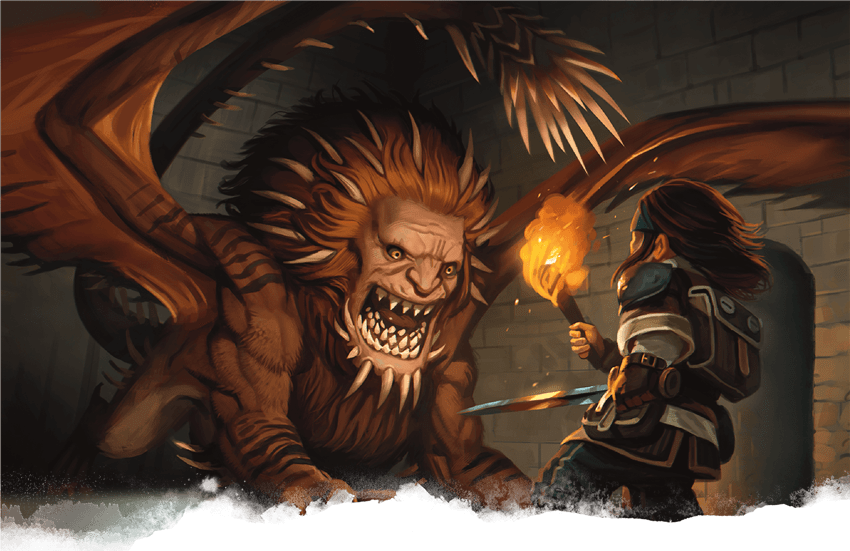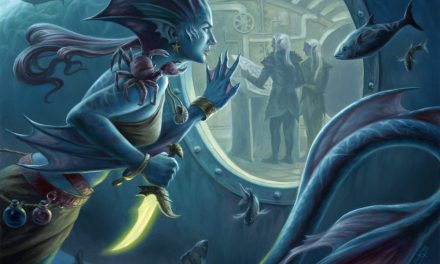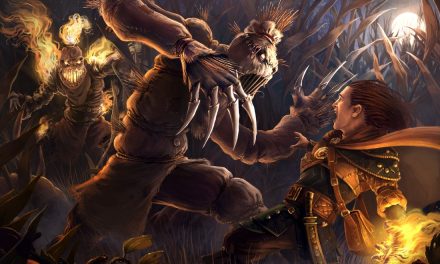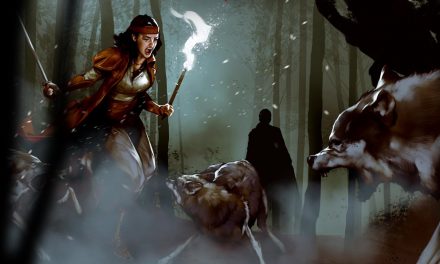Originating in Persian mythology, the Manticore in D&D 5e can prove to be a fearsome encounter for adventurers.
It’s difficult to say what is scariest about these monstrosities. Is it the large tail spikes that they launch at their prey? Their taunting words in Common as they attempt to devour the party? They numerous rows of jagged teeth?
Of course the answer is: all of the above.
A lone Manticore can prove to be a difficult and memorable encounter for a low-level party. However, their tendency to hunt in packs means that even mid-level parties are likely to play it safe when passing through Manticore hunting grounds.
Without further ado, let’s take a closer look at today’s featured monster: the Manticore in D&D 5e.
The Appearance of the Manticore in D&D 5e
Much like the creature of Persian legend, the Manticore possesses the body of a lion, the face of a human (somewhat), and a stinging tail. With its large wings, the Manticore is able to swoop down on unsuspecting prey.
The Manticore’s mane is made of bristles that stretch down the center of its back. On each foot, large and grisly claws threaten to sink into the party members.
Rather than the scorpion tail that they are depicted with in mythology, the Manticore in D&D 5e has 24 large tail spikes. These are thrown at enemies and regrow while the Manticore rests.
The Manticore’s face is vaguely reminiscent of a human face, though its piercing eyes and multiple rows of jagged teeth reveal the creature’s malevolent nature.
For Dungeon Masters that are using a Manticore in their D&D 5e sessions, you will want to call special attention to the creature’s fearsome appearance. Especially if you have new players, the horror of the Manticore can greatly set the stage for an epic battle.
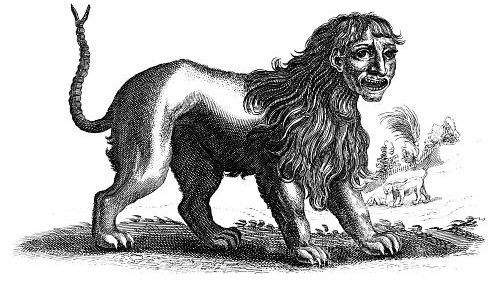
Combat Tactics of the Manticore in D&D 5e
While the Manticore in D&D 5e possesses enough intelligence to converse, it is not particularly clever. These monsters are unlikely to be particularly tactical in how they attack adventurers.
But that’s no reason to get comfortable!
The Manticore possesses deadly predatory instincts. Each aspect of the Manticore’s physique is used to devastating effect when chasing its prey.
Death From Above
The Manticore in D&D 5e gets three attacks on its turn which can be devastating at low levels. They like to attack their targets from the air by throwing their tail spikes at enemies.
Once their prey is weakened or the Manticore is out of tail spikes, it lands to unleash with its claws and teeth.
Hunting in Packs
When stalking particularly large or dangerous prey, Manticores work together to take it down. They use their preferred tactic of throwing tail spikes at it before swooping in with their claws.
Once their target is down, the Manticores share the meal.
Adventurers who see a group of Manticore flying their direction would be wise to take cover. But even then, it may already be too late…
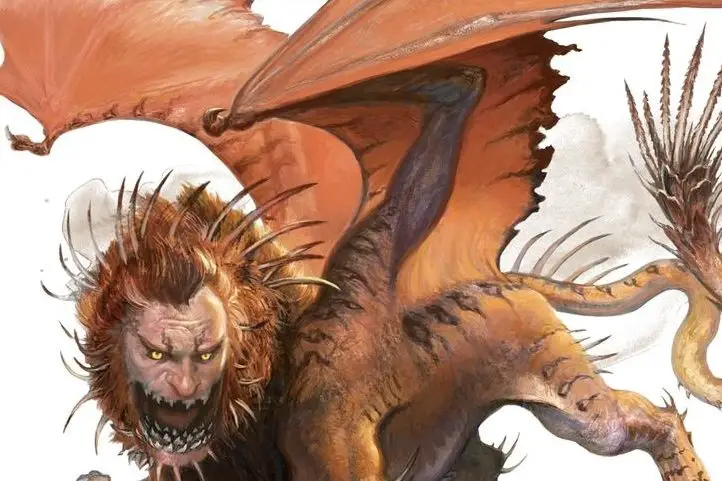
Manticore Behavior
Manticores possess the predatory instincts that one would expect from their appearance. However, they also possess an intelligence that allows them to be cunning and cruel.
Are Manticores Intelligent?
Manticores are intelligent by beast-standards. They aren’t clever or learned creatures, but are intelligent enough to be threatening. The Manticore can make reasonable decisions, determine ideal spots to ambush its prey, and speak.
With their ability to speak Common, the Manticore taunts and insults its prey as it attacks. It is possible (though remarkably bold) to attempt to strike a deal with a Manticore.
If a particularly silver-tongued adventurer is able to bargain for their life with the promise of more food to come, the Manticore may be inclined to agree. But there are few things that a Manticore loves more than flesh and the screams of its victims. Such a deal would have to be very tempting and too good to pass up.
They Play With Their Food
As mentioned, the screams of their prey and the scent of fear in the air are among the Manticore’s favorite things.
When attacking the party, a Manticore taunts its prey to horrifying effect. It condescendingly offers to devour them quickly if they surrender. It may suggest obviously useless tactics to its enemy or describe in detail how they plan to devour them.
Territorial Rivals
Manticores are fiercely territorial and fend off rivals from their preferred hunting grounds. Chimeras, griffons, perytons, and wyverns are the most common rivals that the Manticore must fend off. When such a rival is spotted in their hunting grounds, Manticores will work as a group to fend them off with greater numbers.
Manticore don’t mess with dragons, however. Intelligence score of 7 or not, they know better.
Unlikely Allies
It’s possible that adventurers will find a Manticore in an alliance with some other creature. Hobgoblins or orcs may use them for aerial support in their raids. A Manticore may be tasked with guarding the entrance to a lair or ancient tomb by someone or something that gives it a steady supply of food.
Some giants may even use a Manticore for hunting purposes.
If it results in food (especially of the humanoid variety) and the ability to stalk prey, the Manticore is often open to such arrangements.
Personally, I would like to see what kind of chaos could be created if such an alliance were struck between a Manticore and a Hag…
*evil laughter*
Conclusion – Manticore in D&D 5e
An encounter with a Manticore in D&D 5e is likely to be a memorable experience.
A lone Manticore can be a solid challenge for a party of low-level adventurers. Meanwhile, a group of these monstrosities can also be threatening to mid-level parties.
Their cruel nature and ability to interact with the party give them a ton of usability.
For a Dungeon Master, adding the Manticore’s love of taunting the party while it attacks is a huge opportunity for roleplaying in combat. It adds a great level of tension to the encounter and the party is bound to enjoy saying some words of their own once they’ve defeated the beast!

